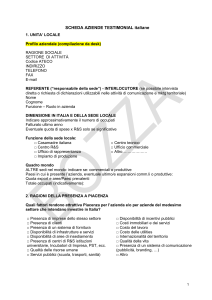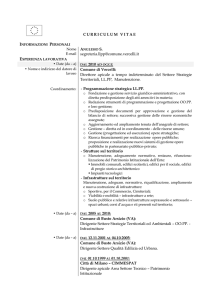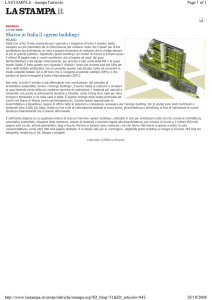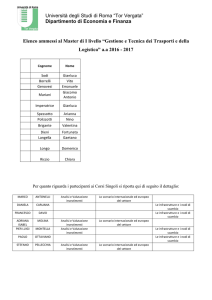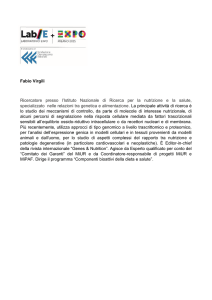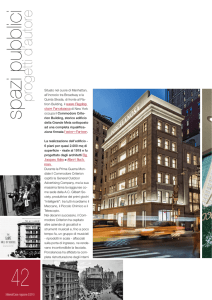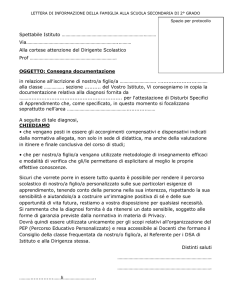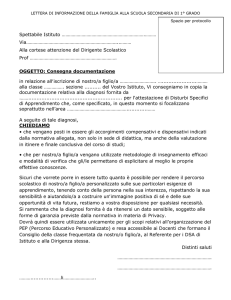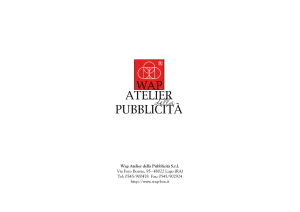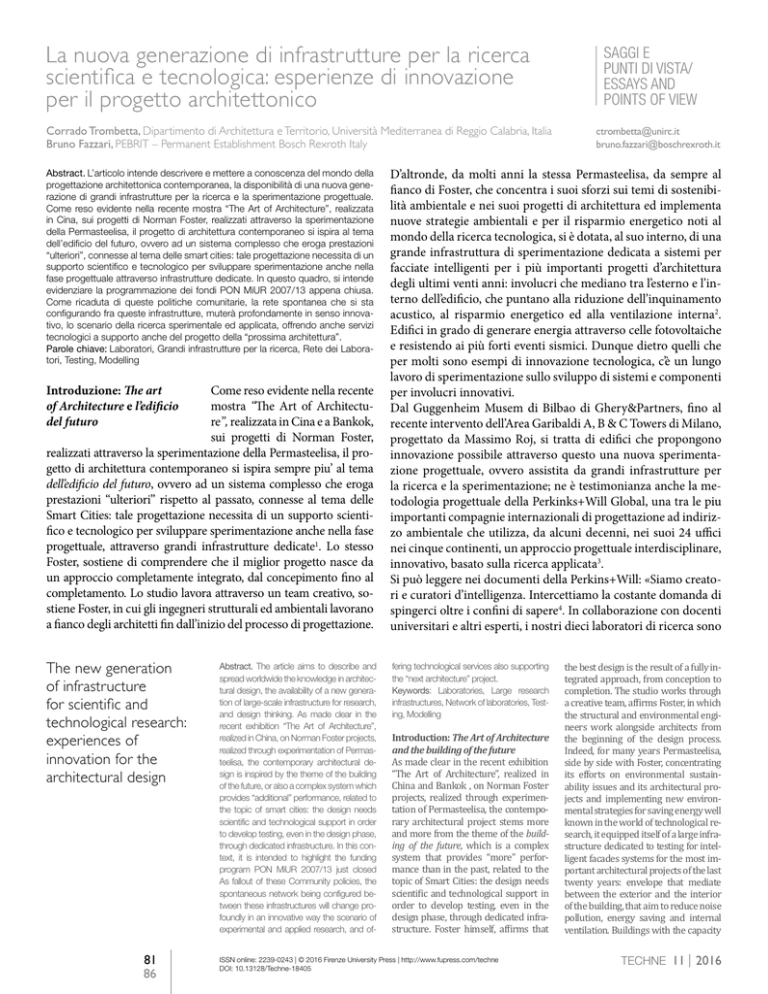
La nuova generazione di infrastrutture per la ricerca
scientifica e tecnologica: esperienze di innovazione
per il progetto architettonico
Corrado Trombetta, Dipartimento di Architettura e Territorio, Università Mediterranea di Reggio Calabria, Italia
Bruno Fazzari, PEBRIT – Permanent Establishment Bosch Rexroth Italy
Abstract. L’articolo intende descrivere e mettere a conoscenza del mondo della
progettazione architettonica contemporanea, la disponibilità di una nuova generazione di grandi infrastrutture per la ricerca e la sperimentazione progettuale.
Come reso evidente nella recente mostra “The Art of Architecture”, realizzata
in Cina, sui progetti di Norman Foster, realizzati attraverso la sperimentazione
della Permasteelisa, il progetto di architettura contemporaneo si ispira al tema
dell’edificio del futuro, ovvero ad un sistema complesso che eroga prestazioni
“ulteriori”, connesse al tema delle smart cities: tale progettazione necessita di un
supporto scientifico e tecnologico per sviluppare sperimentazione anche nella
fase progettuale attraverso infrastrutture dedicate. In questo quadro, si intende
evidenziare la programmazione dei fondi PON MiUR 2007/13 appena chiusa.
Come ricaduta di queste politiche comunitarie, la rete spontanea che si sta
configurando fra queste infrastrutture, muterà profondamente in senso innovativo, lo scenario della ricerca sperimentale ed applicata, offrendo anche servizi
tecnologici a supporto anche del progetto della “prossima architettura”.
Parole chiave: Laboratori, Grandi infrastrutture per la ricerca, Rete dei Laboratori, Testing, Modelling
Introduzione: The art
of Architecture e l’edificio
del futuro
Come reso evidente nella recente
mostra “The Art of Architecture”, realizzata in Cina e a Bankok,
sui progetti di Norman Foster,
realizzati attraverso la sperimentazione della Permasteelisa, il progetto di architettura contemporaneo si ispira sempre piu’ al tema
dell’edificio del futuro, ovvero ad un sistema complesso che eroga
prestazioni “ulteriori” rispetto al passato, connesse al tema delle
Smart Cities: tale progettazione necessita di un supporto scientifico e tecnologico per sviluppare sperimentazione anche nella fase
progettuale, attraverso grandi infrastrutture dedicate1. Lo stesso
Foster, sostiene di comprendere che il miglior progetto nasce da
un approccio completamente integrato, dal concepimento fino al
completamento. Lo studio lavora attraverso un team creativo, sostiene Foster, in cui gli ingegneri strutturali ed ambientali lavorano
a fianco degli architetti fin dall’inizio del processo di progettazione.
The new generation
of infrastructure
for scientific and
technological research:
experiences of
innovation for the
architectural design
81
86
Abstract. The article aims to describe and
spread worldwide the knowledge in architectural design, the availability of a new generation of large-scale infrastructure for research,
and design thinking. As made clear in the
recent exhibition “The Art of Architecture”,
realized in China, on Norman Foster projects,
realized through experimentation of Permasteelisa, the contemporary architectural design is inspired by the theme of the building
of the future, or also a complex system which
provides “additional” performance, related to
the topic of smart cities: the design needs
scientific and technological support in order
to develop testing, even in the design phase,
through dedicated infrastructure. In this context, it is intended to highlight the funding
program PON MiUR 2007/13 just closed
As fallout of these Community policies, the
spontaneous network being configured between these infrastructures will change profoundly in an innovative way the scenario of
experimental and applied research, and of-
SAGGI E
PUNTI DI VISTA/
ESSAYS AND
POINTS OF VIEW
[email protected]
[email protected]
D’altronde, da molti anni la stessa Permasteelisa, da sempre al
fianco di Foster, che concentra i suoi sforzi sui temi di sostenibilità ambientale e nei suoi progetti di architettura ed implementa
nuove strategie ambientali e per il risparmio energetico noti al
mondo della ricerca tecnologica, si è dotata, al suo interno, di una
grande infrastruttura di sperimentazione dedicata a sistemi per
facciate intelligenti per i più importanti progetti d’architettura
degli ultimi venti anni: involucri che mediano tra l’esterno e l’interno dell’edificio, che puntano alla riduzione dell’inquinamento
acustico, al risparmio energetico ed alla ventilazione interna2.
Edifici in grado di generare energia attraverso celle fotovoltaiche
e resistendo ai più forti eventi sismici. Dunque dietro quelli che
per molti sono esempi di innovazione tecnologica, c’è un lungo
lavoro di sperimentazione sullo sviluppo di sistemi e componenti
per involucri innovativi.
Dal Guggenheim Musem di Bilbao di Ghery&Partners, fino al
recente intervento dell’Area Garibaldi A, B & C Towers di Milano,
progettato da Massimo Roj, si tratta di edifici che propongono
innovazione possibile attraverso questo una nuova sperimentazione progettuale, ovvero assistita da grandi infrastrutture per
la ricerca e la sperimentazione; ne è testimonianza anche la metodologia progettuale della Perkinks+Will Global, una tra le piu
importanti compagnie internazionali di progettazione ad indirizzo ambientale che utilizza, da alcuni decenni, nei suoi 24 uffici
nei cinque continenti, un approccio progettuale interdisciplinare,
innovativo, basato sulla ricerca applicata3.
Si può leggere nei documenti della Perkins+Will: «Siamo creatori e curatori d’intelligenza. Intercettiamo la costante domanda di
spingerci oltre i confini di sapere4. In collaborazione con docenti
universitari e altri esperti, i nostri dieci laboratori di ricerca sono
fering technological services also supporting
the “next architecture” project.
Keywords: Laboratories, Large research
infrastructures, Network of laboratories, Testing, Modelling
Introduction: The Art of Architecture
and the building of the future
As made clear in the recent exhibition
“The Art of Architecture”, realized in
China and Bankok , on Norman Foster
projects, realized through experimentation of Permasteelisa, the contemporary architectural project stems more
and more from the theme of the building of the future, which is a complex
system that provides “more” performance than in the past, related to the
topic of Smart Cities: the design needs
scientific and technological support in
order to develop testing, even in the
design phase, through dedicated infrastructure. Foster himself, affirms that
ISSN online: 2239-0243 | © 2016 Firenze University Press | http://www.fupress.com/techne
DOI: 10.13128/Techne-18405
the best design is the result of a fully integrated approach, from conception to
completion. The studio works through
a creative team, affirms Foster, in which
the structural and environmental engineers work alongside architects from
the beginning of the design process.
Indeed, for many years Permasteelisa,
side by side with Foster, concentrating
its efforts on environmental sustainability issues and its architectural projects and implementing new environmental strategies for saving energy well
known in the world of technological research, it equipped itself of a large infrastructure dedicated to testing for intelligent facades systems for the most important architectural projects of the last
twenty years: envelope that mediate
between the exterior and the interior
of the building, that aim to reduce noise
pollution, energy saving and internal
ventilation. Buildings with the capacity
TECHNE 11 2016
in prima linea per indagini e test architettonici. Vedrete come
l’intelligenza che stiamo coltivando assicura soluzioni progettuali personalizzate, significative e più innovative possibile».
Dunque, la riflessione, è che siamo passati dall’atteggiamento
vernacolare del costruire del passato: “buono lo rifaccio, non
buono non lo faccio più”, all’atteggiamento, degli scorsi decenni, dell’innovazione sulla base di (rischiosi) “proiezioni e calcoli
empirici”, all’attuale, molto concreta, opportunità di innovare attraverso il testing, la modellazione reale; ovvero, quella che molti
definiscono “la sindrome del nonno e del nipote”.
Ma come possiamo essere informati e consapevoli riguardo le buone o cattive prestazioni di un edificio, se non dopo molti decenni?
La sperimentazione e il testing di tipo avanzato, con l’assistenza
di team che lavorano durante la fase di progettazione, che forniscono informazioni riguardo le prestazioni delle soluzioni scelte,
sembrano realizzare un sogno: dirci come si comporterà l’edificio e guidarci nelle scelte delle alternative progettuali.
La programmazione di
rafforzamento MiUR-PON
2007/13
In questo quadro, è utile evidenziare che, attraverso la recente programmazione dei fondi PON MiUR 2007/13 appena
chiusa, è stato realizzato in Italia uno straordinario incontro tra
imprese e centri di ricerca universitari, che attraverso adeguate
risorse hanno avuto l’opportunità di ideare, progettare e realizzare una nuova generazione di infrastrutture per la ricerca scientifica e tecnologica, anche per il settore dell’architettura, con lo
scopo di favorire la crescita del sistema della ricerca, ma soprattutto di rendere disponibili macchine ed attrezzature al sistema.
Il fenomeno ha dimensioni riguardevoli; solo il MIUR ha inveof generating energy through photovoltaic cells and resisting the strongest
seismic events. So behind those that
for many are examples of technological innovation, there is a long process of
experimentation on the development
of systems and components for innovative envelopes. From the Guggenheim
Museum in Bilbao by Gehry & Partners,
to the recent intervention Area Garibaldi A, B & C Towers in Milan, designed by
Massimo Roj, we see buildings that can
offer this innovation through a new experimental design, ie assisted by great
infrastructure for research and experimentation; example of this is also the
design methodology of Perkinks+Will
Global, one of the most important international companies to address environmental design that has been using for
several decades, in its 24 offices in five
continents , an interdisciplinary, innovative, applied research-based design
82
approach. You can read in the documents of Perkins+Will: We are creators
and curators of intelligence. We intercept the constant demand to push the
boundaries of knowledge. In collaboration with academics and other experts,
our ten research laboratories are at
the forefront of architectural surveys
and tests. You will see how the intelligence that we are cultivating provides
customized design solutions, the most
significant and innovative as possible.
Therefore, the reflection is that we have
gone from the attitude of the vernacular building of the past: “If it’s good we
do it again, not good we don’t do it anymore”, to the past few decades’ innovation based attitude on (risky) “projections and empirical calculations”, to the
current, very concrete, opportunitiy to
innovate through the testing, and the
actual modeling; in other words, what
many call “the syndrome of the grand-
C. Trombetta, B. Fazzari
stito tra il 2011 e il 2015, attraverso il Programma Infrastrutture
di ricerca € 185 milioni come co-finanziamento per la costruzione, lo sviluppo ed il consolidamento di grandi Infrastrutture
di Ricerca (IR) d’interesse europeo, afferenti a tutte e 5 le cinque
macro-aree identificate dall’European Strategic Forum on Research Infrastructures (ESFRI)5. Il MIUR, sulla base dei dati forniti
dai principali stakeholder (enti pubblici di ricerca e università,
ma non solo) ha elaborato una mappatura delle infrastrutture di
particolare rilevanza per il Paese, da quelle già esistenti a quelle
ancora in fase di progettazione, collocate sul territorio nazionale
o all’estero, classificandole in base ai criteri prodotti dall’ESFRI.
Il Programma
La realizzazione di nuove infrastrutture di ricerca di cui il Paese
soffriva la mancanza e l’upgrade di quelle già presenti sul territorio
nazionale ha fornito al sistema della ricerca e dei progettisti gli strumenti necessari per far avanzare le frontiere della progettazione tecnologica e della conoscenza ed affrontare in maniera più efficace ed
efficiente le grandi sfide della società, sia quelle identificate a livello
comunitario nell’ambito del Programma Quadro Horizon 2020, sia
quelle prioritarie per il nostro Paese.
Naturalmente, tutto ciò, stà già avendo un impatto significativo sul
sistema della Ricerca e della Progettazione Architettonica e Tecnologica. Dal nostro punto di vista, il Programma Infrastrutture andrà
ad incidere sul sistema della ricerca consentendo ai ricercatori di
poter contare su strumentazioni e infrastrutture di livello competitivo, per affrontare le sfide scientifiche e tecnologiche, migliorare la
qualità della ricerca progettuale italiana, incrementandone la competitività nello scenario internazionale e, soprattutto, fornendo uno
straordinario supporto alla progettazione tecnologica.
father and nephew”. But how can we
be informed and aware about the good
or bad performance of a building, if not
after many decades? Experimentation
and testing of advanced type, with the
support teams during the design phase,
which provide information about the
performance of the chosen solutions,
seem to realize a dream: to tell us how
the building will evolve and guide us in
the choices of design alternatives.
The strengthening program MiUR PON 2007/13
In this context, it is useful to highlight
that through the just closed programming of PON funds MiUR 2007/13,
an extraordinary encounter between
companies and university research
centers was made in Italy. Thanks to
adequate resources they had the opportunity to invent, design, and manufacture a new generation of infrastruc-
ture for scientific and technological
research, also for the architectural field,
with the aim to promote the growth of
the research system, but above all to
make available machines and equipment to the system. The phenomenon
has respectable sizes; the Ministry of
Education has invested € 185 million
as co-financing for the construction,
development and consolidation of
large Infrastructure Research (IR) of
European interest, related to all and
5 the five main areas identified by the
European Strategic Forum on Research
Infrastructures (ESFRI) between 2011
and 2015, through the Research Infrastructures Programme. The Ministry of
Education, based on the data provided
by the main stakeholders (public research institutions and universities, but
not only) has developed a mapping of
particular relevance infrastructure for
the country, including the existing ones
TECHNE 11 2016
Da una parte lo sviluppo di nuovi centri di ricerca italiani capaci
di attrarre ricercatori europei, dall’altra il sostegno ai ricercatori
italiani che intendono accedere alle IR localizzate all’estero, favoriranno il dialogo ed il confronto con il sistema della ricerca
internazionale e ciò produrrà la crescita personale, culturale e
scientifica dei ricercatori. Ciò sta favorendo il trasferimento dei
risultati della ricerca e innovazione tecnologica e la formazione
di nuove Aziende Spin-off e Start up per la produzione di prodotti e servizi progettuali ad alto contenuto tecnologico.
Come ricaduta di queste politiche comunitarie, la rete spontanea che si sta configurando
fra queste infrastrutture, sta
mutando profondamente, innovandolo, lo scenario della ricerca sperimentale ed applicata,
offrendo anche servizi tecnologici a supporto anche del progetto
della “prossima architettura”. Per Rete spontanea si intende una
significativa quantità di collaborazioni, ancora priva di accordi o
regole, ma basata sulla reciproca riconoscibilità di scientificità e
innovazione. Tre sono gli elementi da sottolineare.
La rete spontanea delle
grandi infrastrutture
per la ricerca e la
sperimentazione
Il primo è di carattere dimensionale di queste infrastrutture: si
tratta, infatti, di grandi laboratori, che generalmente presentano carattere di forte innovazione che rendono disponibili servizi
tecnologici per il progettista di diverso ordine: analisi termiche,
fisiche, prestazionali su modelli e mokeup reali, sperimentazioni,
test e certificazioni di discipline integrate che consentono anamnesi dettagliate delle condizioni ambientali e fisiche, nonché proiezioni reali delle prestazioni dell’edificio nel tempo.
and those still in the planning stage,
located in the country or abroad, classifying them according to the criteria
produced by ESFRI.
The program
The creation of new research infrastructures, the lack of which was affecting the country, as well as the upgrading of those already present on
the national territory has provided
the research system and the designers
with the tools needed to advance the
frontiers of design and technological
knowledge and to face the major challenges of society in a more 'efficient and
effective’ way, both for those challenges
identified at EU level under the framework Programme Horizon 2020 and
the prioritarian ones for our country.
Of course , all this is already having a
significant impact on the search system and Architectural and Technologi-
83
cal Design. From our point of view, the
Infrastructure Program will impact the
research system allowing researchers
to rely on instruments and competitive level infrastructure, to address the
scientific and technological challenges,
improving the quality of Italian design
research, increasing competitiveness
in international scenario and, above all,
providing an extraordinary support to
technological design. The development
of new Italian research centers capable
of attracting European researchers on
the one hand, and the support to Italian researchers wishing to access the IR
localized abroad on the other, will promote dialogue and confrontation with
the system of international research
and this will produce personal, cultural
and scientific growth for researchers.
All of this is favoring the transfer of
research findings and technological
innovation and the formation of new
C. Trombetta, B. Fazzari
Un buon esempio, estremamente qualificato è l’ITeCons, Instituto de Investigação e Desenvolvimento Tecnológico em Ciências
da Construção, un Istituto per la Ricerca e lo sviluppo tecnologico nel settore delle costruzioni, con particolare attenzione alla
sostenibilità ambientale ed energetica delle soluzioni progettuali,
attivo all’interno dell’Università di Coimbra in Portogallo6. L’ITeCons è gestito da un team di Professori dell’area di ingegneria ed architettura che hanno a disposizione numerose strutture
moderne progettate per lo sviluppo di servizi tecnologici per la
ricerca, la formazione, la sperimentazione per consulenze progettuali e fondamentale appare il loro contributo alla ricerca progettuale. Infatti, l’’Istituto eroga servizi tecnologici a stretto contatto con l’industria, le università, i progettisti e con altri attori
protagonisti del processo costruttivo, con particolare attenzione
alle prestazioni energetiche e ambientali dell’edificio: consulenze
ad ampio raggio per la definizione delle prestazioni tecnologiche,
nella fase progettuale.
Il secondo è di carattere tipologico: ci si riferisce a infrastrutture
che hanno superato la configurazione di mera “somma di attrezzature”, ma si propongono come compendi di macchine progettate e realizzate da ricercatori di diverse discipline al fianco di
aziende e progettisti, per fornire servizi tecnologici di carattere
innovativo, anche attraverso una formazione mirata. Ciò consente di approcciare al progetto in modo completo, coerente e
consapevole.
È il caso dei Laboratori CERT di Oderzo, Treviso, che si suddividono in tre aree principali per la qualificazione e la certificazione dei prodotti nel settore delle costruzioni e sono nati per
supportare le aziende, e i progettisti nella fase di sviluppo di
Spin-off companies and Start-up for the
production of products and design services with high technological content.
The spontaneous network of major
infrastructures for research and experimentation
As fallout of these Community policies,
the spontaneous network being configured between these infrastructures
will change profoundly, innovating the
scenario of experimental and applied
research, and offering technological
services also supporting the “next architecture” project. For Spontaneous
Network it means a significant amount
of collaboration , still without agreements or rules, but based on mutual
recognition of science and innovation.
There are three elements to be emphasized.
The first is the dimensional charac-
ter of these infrastructures: in fact,
we talk about large laboratories, which
generally have highly innovative character that make technology services of
different types available for the designer: thermal and physical analysis, performance on real models and mokeup,
experiments, testing and certification
of integrated disciplines that enable
detailed analysis of environmental and
physical conditions, as well as projections of actual building performance
over time. A good example is the highly
qualified ITeCons, Instituto de Desenvolvimento Tecnológico and Investigação em Ciências by Construção, an
Institute for Research and technological development in the construction industry, with a focus on environmental
and energy sustainability of the design
solutions, within the University of Coimbra in Portugal. The ITeCons is run
by a team of Professors of engineering
TECHNE 11 2016
nuovi prodotti, nella valutazione dell’usabilità e dell’ergonomia
del prodotto7. I Laboratori CERT, fanno parte della Rete dei Laboratori Universitari e della Rete del Laboratori delle Camere di
Commercio Italiane e usano metodologie innovative e tecnologie avanzate per un’analisi preventiva del prodotto.
I test e le sperimentazioni disponibili possono essere compiuti
sia in cantiere che in laboratorio, anche in presenza del produttore, del progettista e del committente/responsabile del cantiere
stesso e riguardano componenti molto diversificati per dimensione, materiali e campo applicativo: serramenti, moduli di facciata continua, sistemi divisori, layout interni, sistemi di rivestimento, pavimenti, arredi e altre componenti edilizie installate
in ambito residenziale e commerciale in molti paesi del mondo.
Nell’ultimo periodo i Laboratori si sono dedicati alla determinazione di sistemi performanti dell’involucro edilizio, in particolare alla posa in opera di serramenti e chiusure finalizzate alla
perfetta adesione con le parti murarie. Il loro contributo alle soluzioni progettuali è strategico per mediare le prestazioni fisicoambientali dell’edificio con le scelte formali e tecnologiche.
Il terzo è di carattere concettuale: le nuove infrastrutture si configurano come una rete pronta ad accogliere nuove istanze di
ricerca scientifica e tecnologica che possono dare un importante
supporto sia al mondo della produzione che a quello della progettazione, a cui oggi si richiedono risposte sostenibili e allo
stesso tempo performanti. Una sorta di laboratorio cognitivo,
dove idee ed ipotesi progettuali e tecnologiche possono trovare
riscontro certo.
Per questo tipo di infrastruttura è certamente da segnalare, il
progetto Building Future Lab.
and architecture, which has a variety of
modern facilities designed for the development of technology services for
the research, training, and testing for
design advice. Their contribution to
design research is of paramount importance. In fact, the Institute delivers technology services in close contact with
industries, universities, designers and
other leading actors of the construction process, with a focus on energy
and environmental performance of the
building: wide-ranging consultations to
define the technological performance
in the design phase.
The second is typological: It refers to
facilities that have exceeded the mere
configuration of “amount of equipment”, but are intended as compendium of machines designed and made by
researchers from different disciplines
alongside companies and designers,
84
to provide services technological innovativeness, even through targeted
training. This allows a complete, coherent and conscious approach to the project. This is the case of the laboratories
CERT of Oderzo and Treviso, which
are divided into three main areas for
the qualification and certification of
products in the construction industry,
and are created to support companies
and designers in the process of new
product development, evaluation of usability and ergonomics of the product.
The CERT Laboratories are part of the
Network of University Laboratories
and the laboratories Network of Italian
Chambers of Commerce and use innovative methodologies and advanced
technologies for prior analysis of the
product. The tests and trials can be
made both on site and in the laboratory,
even in the presence of the producer,
the designer and the client / manager
C. Trombetta, B. Fazzari
Realizzato con fondi MiUR PON, il progetto dell’Università degli Studi Mediterranea di Reggio Calabria, BUILDING FUTURE
Lab, è probabilmente fra le nuove infrastrutture piu vicine all’area
della Tecnologia dell’Architettura8. Il BFL, parte dal presupposto
che l’edificio del Futuro passa dall’opportunità di superare il tradizionale metodo di trasferimento delle esperienze costruttive
al fine di realizzare un trasferimento di tecnologie e competenze
basato sul Testing Avanzato. Le sezioni operative sono fortemente
relazionate e prevedono TEST dinamici relativi alla Sostenibilità
Energetica e Ambientale; prove su Materiali e Componenti, attraverso il TEST MAT&COM, di sottosistemi costruttivi attraverso
TEST LAB il TEST CELL e il TEST ROOM di sistemi morfologici
attraverso TEST DIMORA, Progetto&C, sistemi strutturali attraverso il TEST DINAMICA e negli edifici in uso, attraverso il TEST
MOBILE; edifici in condizioni estreme, ovvero con fondazioni su
acqua, saranno testati attraverso il TEST WATER; completa il quadro un Laboratorio Cognitivo per la definizione delle commesse
per l’innovazione del progetto. L’analisi e la valutazione della sostenibilità dell’innovazione saranno effettuate in un’ottica di ciclo di
vita, secondo i tre aspetti ai quali si riconduce oggi la problematica
della sostenibilità: ambiente, contesto sociale-storico-culturale e
risorse economiche. In tale direzione il progetto intende muoversi
coerentemente con il quadro UE.
Il centro della Laboratorio è il Testing Avanzato delle soluzioni
oggetto di indagine, attraverso l’uso del compendio di macchine
composto dal Test LAB, del Test ROOM e del Test CELL, una
tecnologia, sviluppata con la società Bosch Rexroth, in cui si opera con strumentazioni all’avanguardia, con sistemi mutuati dal
mondo aerospaziale e aeronautico, per la verifica delle prestazioni
dinamiche, la simulazione e il monitoraggio dei comportamenti
of the construction site and cover very
diverse components by size, materials,
and products or services: doors and
windows, continuous façade modules,
partition systems, interior layout, coating systems, floors, furniture and other
building components installed in residential and commercial areas in many
countries of the world. Lately Laboratories have dedicated themselves to the
determination of performance building
envelope systems , in particular the
installation of windows and closures
aimed at the perfect adhesion with the
masonry. Their contribution to design
solutions is strategic to mediate the
physical environmental performance of
the building with the formal and technological choices.
The third is of conceptual nature: the
new infrastructures are configured as
a network ready to accommodate new
instances of scientific and technological research that can give an important
support to both the world of production than to that of the design, which
are asked today to give sustainable and
at the same time performing responses.
A kind of cognitive laboratory, where
ideas and design and technological assumptions may find some corroborating evidence. For this type of infrastructure the Building Future Lab project is
definitely remarkable. Made with MiUR
PON funds, the project of the University Mediterranea of Reggio Calabria,
BUILDING FUTURE Lab, is probably
among the newest infrastructure closer
to the area of Architectural Technology.
The BFL, stems from the assumption
that the building of the future passes by
the opportunity to overcome the traditional method of transferring manufacturing experiences in order to achieve a
transfer of technology and skills based
TECHNE 11 2016
reali dei “sistemi tecnologici”. Immaginate un grande portale di
oltre 16 metri di lato, su cui testare porzioni di involucro edilizio
innovative, con contemporanei riscontri e test nella Room e nella
Cell. In questi giorni si sta completando l’assemblaggio.
Presso il BFL è possibile Modellare, prototipare, sperimentare e
certificare nuovi sistemi e soluzioni tecnologiche per le costruzioni, durante la fase della progettazione con particolare attenzione allo sviluppo di una nuova generazione di involucri edilizi.
Tuttavia, la mappa delle nuove realtà infrastrutturali per la ricerca e sperimentazione è ampia ed articolata e meriterebbe certamente un’analisi piu approfondita.
Esistono, ad esempio, inoltre, numerosi Centri per lo sviluppo
di soluzioni per la sismicità, come il L.E.D.A. (Laboratory of
Earthquake engineering and Dynamic Analysis), presso l’Università di Enna “Kore”, anche in questo caso sviluppato dalla
Bosch Rexroth, che rende già disponibili tavole vibranti, gli attuatori oleodinamici, lo Strong Floor e lo Strong Wall9; o come
il CERISI dell’Università degli Studi di Messina, eccellenza nel
campo dell’Ingegneria Sismica, specializzato nell’analisi di infrastrutture sottoposte a sollecitazioni da sisma, eventi atmosferici e
spinte meccaniche: a Messina oggi è possibile sviluppare progetti
complessi in condizioni estreme, ottenere sperimentazioni e test
di livello internazionale10.
Sono presenti, inoltre, numerosi “Poli per l’Innovazione”
che rendono disponibili laboratori “in rete”, come nel caso di
Cultura&Innovazione, con sede in Calabria, gestore del Distretto
dei Beni Culturali e dell’omonimo Polo di Innovazione. Infatti, il
Polo ha sviluppato e coordina una rete di laboratori sul territo-
on the Advanced Testing. The operative sections are strongly related, and
provide dynamic TEST related to Energy and Environmental Sustainability; tests on materials and components,
through the TEST MAT & COM, test of
constructive subsystems through TEST
LAB TEST CELL, and the TEST ROOM
tests morphological systems through
TEST DIMORA, Project&Co, structural
systems through TEST DINAMICA and
buildings in use, through the TEST MOBILE. Buildings in extreme conditions,
ie with foundations on the water, will be
tested by the TEST WATER, completing
the picture of a Cognitive Laboratory
for the definition of the orders for the
innovation of the project. The analysis
and evaluation of innovation sustainability will be carried out in view of the
life cycle, according to the three aspects
to which the issue of sustainability
is brought back today: environment,
85
social-cultural-historical context and
economic resources. The project aims
to move in this direction in line with the
EU framework.
The heart of the Laboratory is the Advanced testing of the solutions that are
survey subjects, through the use of the
compendium of machines composed
by the LAB Test, Test ROOM and Test
CELL. A technology developed with the
company Bosch Rexroth, which operates with advanced equipment, with
systems borrowed from the aerospace
and aeronautical world, for the verification of dynamic performance, simulation and monitoring of actual behavior
of “technological systems”. Imagine a
large portal of more than 16 meters on
each side, on which to test the innovative building envelope portions, with
contemporary reports and tests in the
Room and Cell. In these days the laboratory is being assembled. At the BFL
C. Trombetta, B. Fazzari
rio regionale che vanno dalla Diagnostica e Restauro, al Monitoraggio, fino alla Modellazione e Valorizzazione. Si tratta gruppi
di ricerca al fianco di aziende che fruiscono di strumentazioni
avanzate per fornire servizi tecnologici per il progetto e la valorizzazione dei Beni Culturali. In Calabria oggi è possibile operare
nel campo della progettazione architettonica dei Beni Culturali
al massimo livello tecnologico, con analisi e modellazioni che
assistono il progettista e la committenza nella valutazione delle
alternative e nella valorizzazione dei beni.
La recente esperienza11, ci insegna che una nuova modalità di
progettazione si sta affermando:
dopo l’opportunità resa dai nuovi materiali e componenti dello
scorso secolo; e dopo il recente avvento dell’informatica, oggi si
rendono disponibili per un profondo cambiamento, le grandi infrastrutture per la ricerca e la sperimentazione.
La prima ricaduta e che la ricerca dell’area della Tecnologia
dell’Architettura, a nostro avviso, si candida, autorevolmente, ad
accogliere anche questo cambiamento.
D’altronde, Mario Lo Sasso, nel suo articolo “La cultura dei Laboratori e la ricerca sperimentale per le costruzioni”12, ha già
avuto modo si sostenere: «il campo della ricerca tecnologica può
candidarsi ad essere fra i principali ambiti capaci di delineare
scenari di concreto sviluppo sia per i forti legami con i processi
produttivi, progettuali e realizzativi, sia per la capacità di trattare
gli aspetti sperimentali che, nei momenti di passaggio verso nuovi assetti, rappresentano un elemento di forte proiezione futura».
Il ruolo della Tecnologia
dell’Architettura
it is possible to create Modeling, Prototype, Performance Test and Certifications of new systems and technology
solutions for the buildings, during the
design phase with particular attention to developing a new generation of
building envelopes. However, the map
of the new infrastructural realities for
research and experimentation is wide
and varied and certainly deserve more
in-depth analysis. There are, for example, numerous centers for the development of solutions for the seismicity, as
the L.E.D.A. (Laboratory of Earthquake
Engineering and Dynamic Analysis),
at the University of Enna "Kore", also
developed with Bosch Rexroth, which
makes available vibrating tables, the
hydraulic actuators, the Strong Strong
Floor and Wall. The CERISI University
of Messina as well, is an excellence in
the field of Earthquake Engineering,
specializing in the analysis of infra-
structure to be subjected to earthquake
loads, weathering and mechanical
thrusts events: in Messina is now possible to develop complex projects in
extreme conditions, get trials and international tests. Furthermore, there
are many Centers for Innovation that
make networked laboratories available as in the case of Culture & Innovation (Cultura&Innovazione), based
in Calabria, which is the district manager of Cultural heritage and of the
Innovation Pole with the same name.
In fact, the Pole has developed and coordinates a network of laboratories in
the region ranging from diagnostics
and Restoration, to monitoring, to the
Modelling and Valuation. These are research groups that stand by the side of
companies that benefit from advanced
instrumentation for the provision of
technological services for the design
and enhancement of cultural heritage.
TECHNE 11 2016
NOTE
Dopo il successo in Cina e Malesia, la mostra che celebra i progetti storici e più rappresentativi dell'architettura di Norman Foster è
stata allestita anche a Bangkok. “The Art of Architecture” è un vero
e proprio viaggio tra alcuni dei progetti più importanti sviluppati da
Foster+Partners, molti dei quali sono stati prodotti con la Permasteelisa Group.
1
Permasteelisa Group è un soggetto leader a livello mondiale nella
progettazione, project management, produzione e installazione di involucri architettonici e sistemi interni. Presente in quattro continenti,
con un network di oltre 50 società in più di 30 paesi e 11 stabilimenti
produttivi, il Gruppo genera un fatturato totale di circa 1,5 miliardi di
euro all'anno .
2
La Perkins+Will è stata patner del Progetto “Regenerative Design
Greeen Strategy”, all’interno del programma Messaggeri della Conoscenza del MiUR, del Dipartimento dArTe dell’Università Mediterranea
di Reggio Calabria, con la UBC di Vancouver, tra il 2013 e il 2014.
3
4
Perkins&Will Global: www.perkinswill.com
PON MiUR Potenziamento strutturale: www.ponrec.it/programma/
interventi/potenziamento/
5
l’ITeCons, fra l’altro, è promotore del 41 IAHS 2016, World Congress
on Housing, Soustainability and Innovation for the Future, che si terrà ina Algrave, portugal, nel settembre 2016 (http://www.iahs2016.
uc.pt).
6
7
st
9
Losasso M. “La cultura dei Laboratori e la ricerca sperimentale per le
costruzioni” in Trombetta C, Lauria M (a cura di), Building Future Lab
Ricerca sperimentale per la Sostenibilità nel Settore delle Costruzioni, Rimini, 2016, Maggioli Editore, ISBN:8891612830.
12
REFERENCES
Garzia, C. and Moretti, A. (2004), Massimo Colomban e la Permasteelisa
1974-2002.
Perkins & Will, Perkins+Will (2010): 75 Years, Vancouver, CA.
AA. VV., (1994) Ove Arup & partners, Arup, London.
Lauria, M. and Trombetta, C. (Ed.) (2016), Building Future Lab. Ricerca sperimentale per la sostenibilità nel settore delle costruzioni, Maggioli Editore,
Santarcangelo di Romagna (RN).
Milardi, M. (2015), “L’Edificio Risorsa. Caratteri e indicatori di eco-efficienza”, in Edilizia, Edizioni Nuova Cultura, Roma.
Romano, R. (2011), Smart Skin Envelope, integrazione architettonica di tecnologie dinamiche e innovative per il risparmio energetico, Firenze University
Press, Firenze.
Il CERT, ha come partner istituzionale lo IUAV di Venezia.
Trombetta, C. and Milardi, M. (2015), “BUILDING FUTURE Lab.: a great
infrastructure for testing”, in Energy Procedia, Elsevier, Vol. 78, pp. 657-662.
Progetto MiUR PONa3_00374 LEDA.
ITECONS – P3E – Platform for Energy Efficiency in Buildings (2014), available at: www.itecons.uc.pt/index.php?module=pubs&id=13
Building Future Lab. Ricerca sperimentale per la sostenibilità nel settore
delle costruzioni, a cura di M. Lauria e C. Trombetta, Maggioli Editore,
Politecnica, 2016.
8
La BoschRexroth è stata protagonista dello sviluppo di alcuni brevetti delle grandi macchine del BFL: fra i quali:Trombetta C, Milardi M,
Rossetti M (2014). Apparecchiatura per prove di permeabilità all’acqua
su campioni di facciate di edifici. Patent: IO 52938 – IT CS20140035.
15/07/2015.
11
10
Progetto MiUR PONa3_00422 CERISI.
In Calabria is now possible to operate in
the field of architectural design of cultural heritage at the highest technological level, with analysis and modeling
that assist the designer and the client in
the evaluation of alternatives and of the
enhancement of the heritage.
The role of Architectural Technology
Recent experience teaches us that a
new design mode is emerging: after
the opportunities stemming from new
materials and components of last century, and after the recent advent of information technology, today large-scale
infrastructure for research and experimentation become available for a profound change. The first relapse and that
the area of Architectural Technology
Research, in our opinion, is a candidate,
authoritatively, to accommodate this
change. Nonetheless, Mario Losasso,
in his article “The culture of laboratories and experimental research for
the buildings”, stated that «the field
of technological research can aspire
86
to be among the main areas capable
of outlining scenarios of concrete development because of both the strong
bonds with the production, planning,
and implementation processes, and the
ability to treat the experimental aspects
which, in the moments of transition to
the new structures, represent a strong
element of future projection».
NOTES
1
After the success in China and Malaysia, the exhibition that celebrates
the historical and most representative
designs of the architecture of Norman Foster has also been set up in
Bangkok. “The Art of Architecture”
is a real journey through some of the
most important projects developed
by Foster+Partners, many of which
were produced with the Permasteelisa
Group.
2
Permasteelisa Group is a worldwide
leader in the design, project management, manufacturing and installation
of architectural envelopes and inter-
C. Trombetta, B. Fazzari
White, A. and Holmes, M. (2009), “Advanced Simulation Applications Using
Room”, Building Simulation conference.
nal systems. Active on four continents,
with a network of over 50 companies in
more than 30 countries and 11 production plants, the Group generates a total
revenue of approximately 1.5 billion
euro per year.
3
Perkins+Will has been patner of the
project “Regenerative Design Greeen
Strategy”, within the Messengers of
the MiUR Knowledge program of the
dArTe department of the Mediterranean University of Reggio Calabria,
with UBC Vancouver, between 2013
and 2014.
4
Perkins&Will Global: www.perkinswill.com
5
PON MiUR Potenziamento strutturale: www.ponrec.it/programma/interventi/potenziamento/
6
The ITeCon, among other things, is
promoter of the 41st IAHS 2016, World
Congress on Housing, Soustainability
and Innovation for the Future, che si
terrà ina Algrave, Portugal, on september 2016 (http://www.iahs2016.
uc.pt).
7
CERT, has as its institutional partner
IUAV of Venice.
8
Building Future Lab. Sperimental
research for sustainability in the field
of building, edited by M. Lauria and C.
Trombetta, Maggioli Editore, Politecnica, 2016.
9
MiUR PONa3_00374 LEDA Program.
10
MiUR PONa3_00422 CERISI Program
11
Bosch Rexroth was the protagonist
in the development of some of the
patents of large BFL machines, including: Trombetta C, Milardi M, Rossetti M
(2014). Equipment for water permeability testing of facades of buildings.
Patent: IO 52938 - IT CS2014003 .
15/07/2015
12
Losasso M., “La cultura dei Laboratori
e la ricerca sperimentale per le costruzioni” (The culture of Laboratories and
the sperimental research for buildings)
in Trombetta C., Lauria M. (edited by).
Building Future Lab Ricerca sperimentale per la Sostenibilità nel Settore delle
Costruzioni. Rimini, 2016, Maggioli Editore, ISBN:8891612830.
TECHNE 11 2016

